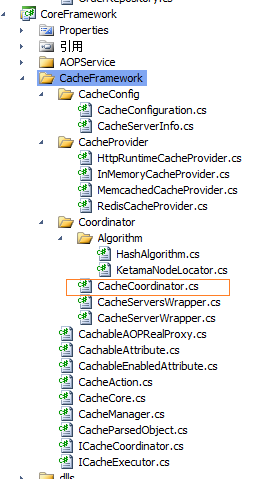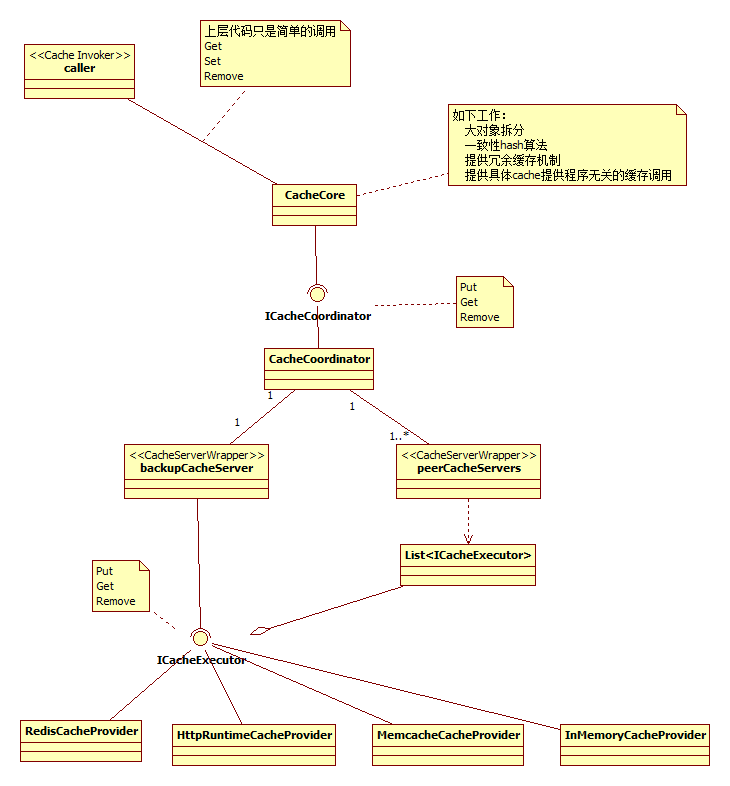缓存子系统如何设计
大家对这段代码肯定很熟悉吧:
public List<UserInfo> SearchUsers(string userName) { string cacheKey=string.Format("SearchUsers_{0}", userName); List<UserInfo> users = cache.Find(cacheKey) as List<UserInfo>; if (users == null) { users = repository.GetUsersByUserName(userName); cache.Set(cacheKey, users); } return users; } class HttpRuntimeCache { public object Find(string key) { return HttpRuntime.Cache[key]; } public void Set(string key, object value) { HttpRuntime.Cache[key] = value; } }
导致了如下这些问题:
- 业务逻辑函数中引入了很多无关的缓存代码,导致DDD模型不够纯
- 更换缓存Provider不方便
- 加入缓存冗余机制不方便
- 没办法同时使用多个缓存系统
- 缓存大对象出现异常,比如Memcache有1M的value限制
有诸多问题,因此我们需要引入缓存子系统来解决上述问题,带来的好处:
- DDD模型更加纯
- 具体的Cache实现机制可以很灵活,比如HttpRuntimeCache, Memcache, Redis可以同时使用
- 加入了Cache冗余机制,不会由于某一台Memcache或者Redis down机导致系统速度很慢,实际上,系统还是会保持飞快(除非backup也down了的情况)
- 开发人员更加致力于核心业务,不会分散注意力
- 缓存位置透明化,都会在xml配置文件中进行配置
解决方案,要用到这2篇文章的技术:C# 代理应用 - Cachable 和 聊聊Memcached的应用。
主要的思路分2个:
模型端:通过代理来嵌入AOP方法,来判断是否需要缓存,有缓存value则直接返回value;缓存value的写入是通过AOP的后置方法写入的,因此不需要在业务函数中写代码,当然也支持代码调用。
Cache核心对象:这个对象要解决一致性hash算法、cache value大对象分解功能、冗余机制
代理嵌入AOP的方法,已经在这篇文章中说明了 C# 代理应用 - Cachable,有兴趣的看看,这里就不说了,我们来主要看看CacheCoordinator对象的实现
结构图如下:

先来看看UML图:

CacheCore代码(算法核心):
public class CacheCore { private ICacheCoordinator cacheProvider = null; public CacheCore(ICacheCoordinator cacheProvider) { this.cacheProvider = cacheProvider; } public void Set(string location, string key, object value) { AssureSerializable(value); string xml = Serializer2XMLConvert(value); CacheParsedObject parsedObj = new CacheParsedObject(); string classType = string.Format("{0}", value.GetType().FullName); if (xml.Length > CacheConfig.CacheConfiguration.MaxCacheEntitySize) { /* key:1@3@ConcreteType key_1:subvalue1 key_2:subvalue2 key_3:subvalue3 */ //拆分成更小的单元 int splitCount = xml.Length / CacheConfig.CacheConfiguration.MaxCacheEntitySize; if (CacheConfig.CacheConfiguration.MaxCacheEntitySize * splitCount < xml.Length) splitCount++; parsedObj.MainObject = new KeyValuePair<string, string>(key, string.Format("1@{0}@{1}", splitCount, classType)); for (int i = 0; i < splitCount;i++ ) { if (i == splitCount - 1) //最后一段,直接截取到最后,不用给出长度 parsedObj.SplittedElements.Add(xml.Substring(i * CacheConfig.CacheConfiguration.MaxCacheEntitySize)); else //其他,要给出长度 parsedObj.SplittedElements.Add(xml.Substring(i * CacheConfig.CacheConfiguration.MaxCacheEntitySize, CacheConfig.CacheConfiguration.MaxCacheEntitySize)); } } else { /* key:1@1@ConcreteType key_1:value */ parsedObj.MainObject = new KeyValuePair<string, string>(key, string.Format("1@1@{0}", classType)); parsedObj.SplittedElements.Add(xml); } //针对CacheParsedObject进行逐项保存 this.cacheProvider.Put(parsedObj.MainObject.Key, parsedObj.MainObject.Value); int curIndex = 0; foreach(string xmlValue in parsedObj.SplittedElements) { curIndex++; string tkey=string.Format("{0}_{1}", parsedObj.MainObject.Key, curIndex); this.cacheProvider.Put(tkey, xmlValue); } } public object Get(string location, string key) { string mainObjKeySetting = (string)cacheProvider.Get(key); if (mainObjKeySetting == null || mainObjKeySetting.Length == 0) return null; string classType; CacheParsedObject parsedObj; GetParsedObject(key, mainObjKeySetting, out classType, out parsedObj); string xmlValue=string.Empty; parsedObj.SplittedElements.ForEach(t=>xmlValue+=t); using (StringReader rdr = new StringReader(xmlValue)) { //Assembly.Load("Core"); Type t = Type.GetType(classType); XmlSerializer serializer = new XmlSerializer(t); return serializer.Deserialize(rdr); } } public void Remove(string location, string key) { string mainObjKeySetting = (string)cacheProvider.Get(key); if (mainObjKeySetting == null || mainObjKeySetting.Length == 0) return; string classType; CacheParsedObject parsedObj; GetParsedObject(key, mainObjKeySetting, out classType, out parsedObj); int i = 1; parsedObj.SplittedElements.ForEach(t => this.cacheProvider.Remove(string.Format("{0}_{1}", parsedObj.MainObject.Key, i++))); this.cacheProvider.Remove(parsedObj.MainObject.Key); } private void GetParsedObject(string key, string mainObjKeySetting, out string classType, out CacheParsedObject parsedObj) { int from = 1, end = 1; classType = string.Empty; if (mainObjKeySetting.IndexOf('@') > 0) { end = int.Parse(mainObjKeySetting.Split('@')[1]); classType = mainObjKeySetting.Split('@')[2]; } parsedObj = new CacheParsedObject(); parsedObj.MainObject = new KeyValuePair<string, string>(key, string.Format("1@{0}@{1}", end, classType)); for (int i = from; i <= end; i++) parsedObj.SplittedElements.Add((string)this.cacheProvider.Get(string.Format("{0}_{1}", parsedObj.MainObject.Key, i))); } private string Serializer2XMLConvert(object value) { using (StringWriter sw = new StringWriter()) { XmlSerializer xz = new XmlSerializer(value.GetType()); xz.Serialize(sw, value); return sw.ToString(); } } private void AssureSerializable(object value) { if (value == null) throw new Exception("cache object must be Serializable"); if (value.GetType().GetCustomAttributes(typeof(SerializableAttribute), true).Count()<=0) throw new Exception("cache object must be Serializable"); } }
下面是CacheCoordinator的代码,这个类的加入目的是要加入缓存的冗余机制:
class CacheCoordinator : ICacheCoordinator { CacheServerWrapper backupCacheServer = new CacheServerWrapper(CacheConfig.CacheConfiguration.BackupCacheServer); CacheServersWrapper peerCacheServer = new CacheServersWrapper(CacheConfig.CacheConfiguration.PeerCacheServers); public void Put(string key, object value) { peerCacheServer.Put(key, value); backupCacheServer.Put(key, value); //缓存冗余 } public object Get(string key) { object o=peerCacheServer.Get(key); if (o != null) return o; return backupCacheServer.Get(key); } public void Remove(string key) { peerCacheServer.Remove(key); backupCacheServer.Remove(key); } }
剩下的就是具体的CacheProvider和CacheProviderWrapper类了:
public class CacheServerWrapper : ICacheExecutor { ICacheExecutor executor = null; private CacheServerInfo configInfo; public CacheServerWrapper(CacheServerInfo configInfo) { this.configInfo = configInfo; ICacheExecutor tmpExecutor = null; switch(this.configInfo.ServerType) { case CacheServerType.HttpRuntime: tmpExecutor = new CacheProvider.HttpRuntimeCacheProvider(configInfo); break; case CacheServerType.InMemory: tmpExecutor = new CacheProvider.InMemoryCacheProvider(configInfo); break; case CacheServerType.Memcached: tmpExecutor = new CacheProvider.MemcachedCacheProvider(configInfo); break; case CacheServerType.Redis: tmpExecutor = new CacheProvider.RedisCacheProvider(configInfo); break; default: tmpExecutor = new CacheProvider.HttpRuntimeCacheProvider(configInfo); break; } executor = tmpExecutor; } public string FullServerAddress { get { return this.configInfo.FullServerAddress; } } public void Put(string key, object value) { executor.Put(key, value); } public object Get(string key) { return executor.Get(key); } public void Remove(string key) { executor.Remove(key); } }
只贴出Memcache的操作类
class MemcachedCacheProvider : ICacheExecutor { private MemcachedClient mc = new MemcachedClient(); private CacheServerInfo configInfo; public MemcachedCacheProvider(CacheServerInfo configInfo) { this.configInfo = configInfo; //初始化池 SockIOPool pool = SockIOPool.GetInstance(); pool.SetServers(new string[] { string.Format("{0}:{1}", configInfo.ServerAddress, configInfo.ServerPort) });//设置连接池可用的cache服务器列表,server的构成形式是IP:PORT(如:127.0.0.1:11211) pool.InitConnections = 3;//初始连接数 pool.MinConnections = 3;//最小连接数 pool.MaxConnections = 5;//最大连接数 pool.SocketConnectTimeout = 1000;//设置连接的套接字超时 pool.SocketTimeout = 3000;//设置套接字超时读取 pool.MaintenanceSleep = 30;//设置维护线程运行的睡眠时间。如果设置为0,那么维护线程将不会启动,30就是每隔30秒醒来一次 //获取或设置池的故障标志。 //如果这个标志被设置为true则socket连接失败,将试图从另一台服务器返回一个套接字如果存在的话。 //如果设置为false,则得到一个套接字如果存在的话。否则返回NULL,如果它无法连接到请求的服务器。 pool.Failover = true; pool.Nagle = false;//如果为false,对所有创建的套接字关闭Nagle的算法 pool.Initialize(); } public void Put(string key, object value) { mc.Set(key, value); } public object Get(string key) { return mc.Get(key); } public void Remove(string key) { mc.Delete(key); } }
不能忘了可配置性,xml定义及代码如下:
<?xml version="1.0" encoding="utf-8" ?> <CacheConfig> <MaxCacheEntitySize>1048576</MaxCacheEntitySize><!--1*1024*1024--> <PeerCacheServers> <CacheServer> <ServerType>InMemory</ServerType> <ServerAddress>127.0.0.1</ServerAddress> <ServerPort>11211</ServerPort> </CacheServer> <CacheServer> <ServerType>InMemory</ServerType> <ServerAddress>127.0.0.1</ServerAddress> <ServerPort>11212</ServerPort> </CacheServer> </PeerCacheServers> <BackupCacheServer> <CacheServer> <ServerType>InMemory</ServerType> <ServerAddress>127.0.0.1</ServerAddress> <ServerPort>11213</ServerPort> </CacheServer> </BackupCacheServer> </CacheConfig>
读取配置信息的代码:
public static class CacheConfiguration { static CacheConfiguration() { Load(); } private static void Load() { PeerCacheServers = new List<CacheServerInfo>(); BackupCacheServer = null; XElement root = XElement.Load(System.IO.Path.Combine(AppDomain.CurrentDomain.BaseDirectory, "CacheConfig.xml")); MaxCacheEntitySize = int.Parse(root.Element("MaxCacheEntitySize").Value); foreach (var elm in root.Element("PeerCacheServers").Elements("CacheServer")) { CacheServerInfo srv = new CacheServerInfo(); srv.ServerAddress = elm.Element("ServerAddress").Value; srv.ServerPort = int.Parse(elm.Element("ServerPort").Value); srv.ServerType = (CacheServerType)Enum.Parse(typeof(CacheServerType), elm.Element("ServerType").Value); PeerCacheServers.Add(srv); } foreach (var elm in root.Element("BackupCacheServer").Elements("CacheServer")) { CacheServerInfo srv = new CacheServerInfo(); srv.ServerAddress = elm.Element("ServerAddress").Value; srv.ServerPort = int.Parse(elm.Element("ServerPort").Value); srv.ServerType = (CacheServerType)Enum.Parse(typeof(CacheServerType), elm.Element("ServerType").Value); BackupCacheServer = srv; break; } if (PeerCacheServers.Count <= 0) throw new Exception("Peer cache servers not found."); if (BackupCacheServer == null) throw new Exception("Backup cache server not found."); AssureDistinctFullServerAddress(PeerCacheServers); } private static void AssureDistinctFullServerAddress(List<CacheServerInfo> css) { Dictionary<string, int> map = new Dictionary<string, int>(); foreach(CacheServerInfo csInfo in css) { if (map.ContainsKey(csInfo.FullServerAddress)) throw new Exception(string.Format("Duplicated server address found [{0}].", csInfo.FullServerAddress)); else map[csInfo.FullServerAddress] = 1; } } public static int MaxCacheEntitySize { get; set; } public static List<CacheServerInfo> PeerCacheServers { get; set; } public static CacheServerInfo BackupCacheServer { get; set; } }
自省推动进步,视野决定未来。
心怀远大理想。
为了家庭幸福而努力。
用A2D科技,服务社会。
心怀远大理想。
为了家庭幸福而努力。
用A2D科技,服务社会。
